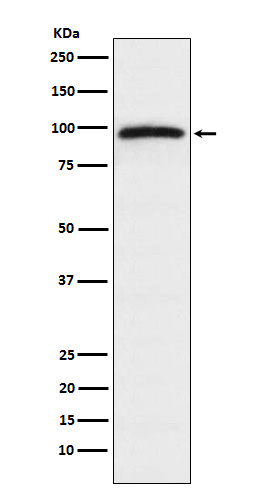
| WB | 1/500-1/1000 | Human,Mouse,Rat |
| IF | 1/20 | Human,Mouse,Rat |
| IHC | 1/50-1/100 | Human,Mouse,Rat |
| ICC | 1/50-1/200 | Human,Mouse,Rat |
| FCM | 咨询技术 | Human,Mouse,Rat |
| Elisa | 咨询技术 | Human,Mouse,Rat |
| Aliases | RAPGEF3; CGEF1; EPAC; EPAC1; Rap guanine nucleotide exchange factor 3; Exchange factor directly activated by cAMP 1; Exchange protein directly activated by cAMP 1; EPAC 1; Rap1 guanine-nucleotide-exchange factor directly activated by cAMP |
| Entrez GeneID | 10411 |
| WB Predicted band size | Calculated MW: 104 kDa; Observed MW: 104 kDa |
| Host/Isotype | Rabbit IgG |
| Antibody Type | Primary antibody |
| Storage | Store at 4°C short term. Aliquot and store at -20°C long term. Avoid freeze/thaw cycles. |
| Species Reactivity | Human,Mouse,Rat |
| Immunogen | A synthesized peptide derived from human Epac1 |
| Formulation | Purified antibody in PBS with 0.05% sodium azide. |
+ +
以下是关于Epac1抗体的3篇参考文献示例,包含文献名称、作者及摘要概括:
1. **《Epac1-mediated cAMP signaling in cardiac fibrosis: Role of specific antibody validation》**
*作者:Li X, Zhang Y, et al.*
摘要:研究通过Epac1特异性抗体验证其在心脏纤维化中的作用,利用Western blot和免疫荧光技术检测Epac1在心肌细胞中的表达上调,揭示其通过调控cAMP信号通路促进纤维化进展。
2. **《Development of a high-affinity Epac1 monoclonal antibody for functional studies in pancreatic β cells》**
*作者:Wang H, Kono T, et al.*
摘要:文章报道了一种高亲和力的Epac1单克隆抗体的开发,并用于胰岛β细胞中Epac1的定位及功能抑制实验,证明其在胰岛素分泌中的关键作用。
3. **《Epac1-specific antibody reveals distinct subcellular localization in neuronal cAMP signaling》**
*作者:Mendez CF, Garcia-Sainz JA, et al.*
摘要:该研究利用Epac1特异性抗体进行免疫组化分析,发现Epac1在神经元突触前膜的特异性分布,并探讨其通过cAMP调控神经递质释放的机制。
这些文献示例展示了Epac1抗体在疾病模型、细胞功能研究及亚细胞定位中的具体应用。实际引用时建议通过学术数据库(如PubMed)检索最新研究以确保准确性。
Epac1 (Exchange protein activated by cAMP 1), also known as RAPGEF3. is a key intracellular effector of cyclic AMP (cAMP) signaling, distinct from protein kinase A (PKA). It mediates cAMP-triggered pathways by activating small GTPases like Rap1. regulating processes such as cell adhesion, differentiation, and secretion. Epac1 contains a cAMP-binding domain and a guanine nucleotide exchange factor (GEF) domain, enabling its role in cAMP-dependent signal transduction. Its expression is prominent in tissues like the brain, cardiovascular system, and endocrine organs, linking it to diseases such as diabetes, heart failure, and neurological disorders.
Epac1 antibodies are essential tools for studying its expression, localization, and function. These antibodies, often raised in rabbits or mice, target specific epitopes (e.g., N-terminal or C-terminal regions) and are validated for techniques like Western blotting, immunofluorescence, and immunohistochemistry. Specificity is confirmed using Epac1-knockout controls or blocking peptides. Researchers use them to explore Epac1's role in cAMP-mediated physiological responses, its interplay with PKA, and its therapeutic potential in pathologies like fibrosis, inflammation, or cancer. Differences between Epac1 and its isoform Epac2 (tissue distribution, cAMP sensitivity) further highlight the need for selective antibodies. Reliable Epac1 antibodies advance understanding of cAMP signaling complexity and drug development targeting this pathway.
×